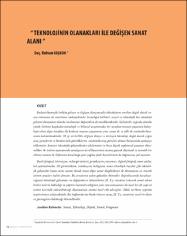| dc.date.accessioned | 2020-06-16T08:16:30Z | |
| dc.date.available | 2020-06-16T08:16:30Z | |
| dc.date.issued | 2014 | en_US |
| dc.identifier.citation | Coşkun, R. (2014). Teknolojinin olanakları ile değişen sanat alanı. Sanat ve Tasarım Dergisi, 6 (6), 76-89. | en_US |
| dc.identifier.issn | 2146-7692 | |
| dc.identifier.uri | https://hdl.handle.net/11421/23328 | |
| dc.description.abstract | Endüstrileşmeyle birlikte gelişen ve değişen dünyamızda teknolojinin sınırları doğal olarak insan zekasının da sınırlarını zorlamaktadır. İnsanlığın kültürel, sosyal ve teknolojik her alandaki
gelişimi dünyamızı olumlu ve olumsuz değişimlere de sürüklemektedir. Gelişmeler ışığında olumlu
yönde ilerleme kaydeden teknolojik ve bilimsel araştırmalar bir taraftan insanın yaşamını kolaylaştırırken diğer taraftan da binlerce insanın yaşamının yine insan eli ve aklı ile sonlandırılmasında kullanılmaktadır. 20 yy. ile birlikte değişen dünya ve ilerleyen teknoloji, doğal olarak çağın
araç-gereçlerini ve beraberinde getirdiklerini, sanatında araç gereçleri olması konusunda sanatçıyı
etklemiştir. Sanatın teknolojik gelişmelerden etkilenmesi ise hıza dayalı toplumsal yaşamın dinamikleri ile üretim aşamasında sanatçının da el becerisinin önüne geçerek düşünsel ve tematik bir
etkinin zaman ile ilişkisinin kurulduğu yeni çağdaş ifade biçimlerinin de doğmasına yol açmıştır.
Basılı fotoğraf, televizyon, video görüntüsü, projeksiyon yansıması, digital fotoğraf, neon ışıklar,
led aydınlatmalar, 3D görüntüleme, simülasyon, hologram, nano teknolojik boyalar gibi teknolojik gelişmeler başta resim sanatı olmak üzere diğer sanat disiplinlerini de dönüştüren en önemli
üretim araçları halini almıştır. Bu araştırma yakın gelecekte ihtimaller doğrultusunda karşılaşacağımız teknolojik gelişmeler ve değişimlerin tahminlerini 20. Y.y. sanatına bakarak sanat adına
bizleri nelerin beklediği ve yapıtın biçimsel varlığının yanı sıra sunuşunun da nasıl bir alt yapı ve
zemin üzerinde yükselebileceği düşüncesiyle sanata nasıl etki edeceğini, eldeki verilerin ışığında
tespit etmeye çalışmaktadır. Bu bağlamda varılmak istenen sonuç 21. Y.y. sanatının nasıl bir alanı
ve görüngüsü olabileceği ihtimalleridir. | en_US |
| dc.description.abstract | The frontiers of technology, in an ever changing and developing world along with industrialization, naturally push the envelope of human intelligence as well. Development of humanity in all the
cultural, social, and technological fields leads our world to both positive and negative alterations.
While the technological and scientific research, which made progress in positive direction in the
light of advancements, on the one hand facilitate human life, yet the same have also been used to
end the lives of thousands of people by human hands and minds, on the other. The world as changed and the technology as advanced with the 20th Century naturally influenced artists in such a
way that the tools and equipment of the time and the ‘things’ that were brought apart by the new
age have become the tools and equipment of art as well. Impact of technological advancements on
art took precedence also over the manual dexterity of the artist during the production phase with
the speed-based dynamics of social life and gave a life to new contemporary forms of expression, in
which a relationship between an ideational and thematic effect, and time.
Such technological advancements as printed photographs, television, video display, projection
reflex, digital photography, neon lights, led illumination, 3D imaging, simulation, hologram, and
nano technological paints have become the most prominent means of production that transformed
primarily the art of painting and also the other disciplines of art. This study aims to determine,
in the light of available data, what lies ahead for art, taking into consideration the predictions
regarding the prospective technological advancements and changes in a near future, with a comparative overview of 20th century art, on which infrastructure and ground the formal existence
of artwork will rise along with its presentation, and how art will be influenced therefrom. In the
context thereof, the intended goal of this study is to come up with probable fields and phenomena
of 21st Century art. | en_US |
| dc.language.iso | tur | en_US |
| dc.publisher | Anadolu Üniversitesi | en_US |
| dc.rights | info:eu-repo/semantics/openAccess | en_US |
| dc.subject | Sanat | en_US |
| dc.subject | Teknoloji | en_US |
| dc.subject | Dijital | en_US |
| dc.subject | Sanal | en_US |
| dc.subject | Fragman | en_US |
| dc.subject | Art | en_US |
| dc.subject | Technology | en_US |
| dc.subject | Digital | en_US |
| dc.subject | Virtual | en_US |
| dc.subject | Fragment | en_US |
| dc.title | Teknolojinin olanakları ile değişen sanat alanı | en_US |
| dc.title.alternative | Field of art as changed with technological opportunities | en_US |
| dc.type | article | en_US |
| dc.relation.journal | Sanat ve Tasarım Dergisi | en_US |
| dc.contributor.department | Anadolu Üniversitesi, Güzel Sanatlar Fakültesi, Resim Bölümü | en_US |
| dc.identifier.volume | 6 | en_US |
| dc.identifier.issue | 6 | en_US |
| dc.identifier.startpage | 76 | en_US |
| dc.identifier.endpage | 89 | en_US |
| dc.relation.publicationcategory | Makale - Ulusal Hakemli Dergi - Kurum Öğretim Elemanı | en_US |
| dc.contributor.institutionauthor | Coşkun, Rıdvan | |


















